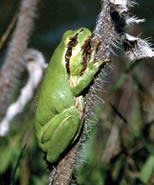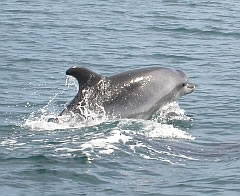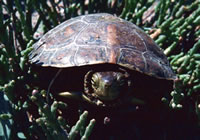 |
Sado estuary, western Portugal
by Teresa Farino
A broad, shallow estuary to the south of Lisboa, of international significance for its breeding and wintering waterbirds and also encompassing well-conserved sand-dune habitats with a rich endemic flora.
 Stripeless Tree Frog
Stripeless Tree Frog
Hyla meridionalis
© Teresa Farino
Looking south from the heights of the Serra da Arrábida, the silver and blue tapestry of the
Sado estuary lies glistening in the sun, its mudflats and sandbanks almost completely exposed
at low tide, with the aquamarine current of the river Sado itself surging through the narrow
gap between the Tróia peninsula and the fishing port of Setúbal.
The shallow alluvial basin which forms the heart of estuary is by no means untouched by man,
but even so is one of the best birdwatching sites in Portugal. The conversion of large areas
of peripheral marsh into rice paddies, saltpans and fish-farms has increased the range of
habitats available to feeding and roosting birds, particularly when the tide is high, while
the surrounding forests of pines and cork oak, which extend for many kilometres, are a haven
for non-aquatic species.
Fauna of the Sado estuary
The Sado estuary has been declared a reserva natural (23,971ha), Ramsar Site and a Special
Protection Area for Birds (SPA), largely on account of the 300-plus species of vertebrate
recorded here. More than 40 species of fish use the area as a nursery, including Lusitanian
 Bottle-nosed Dolphin Tursiops truncatus
© Teresa Farinotoadfish (the most abundant), undulate ray, European conger, shore pipefish and dragonet, plus
a large population of Twaite shad. Notable amphibians and reptiles in the reserve include
southern marbled newt, west Iberian painted frog, both common and stripeless tree frogs,
natterjack, Spanish (stripe-necked) terrapin, ocellated and spiny-footed lizards, large and
Spanish psammodromus and Montpellier snake, while outstanding among the mammals are the
nationally scarce barbastelle bat, Cabrera's vole, otter, western polecat and bottle-nosed
Bottle-nosed Dolphin Tursiops truncatus
© Teresa Farinotoadfish (the most abundant), undulate ray, European conger, shore pipefish and dragonet, plus
a large population of Twaite shad. Notable amphibians and reptiles in the reserve include
southern marbled newt, west Iberian painted frog, both common and stripeless tree frogs,
natterjack, Spanish (stripe-necked) terrapin, ocellated and spiny-footed lizards, large and
Spanish psammodromus and Montpellier snake, while outstanding among the mammals are the
nationally scarce barbastelle bat, Cabrera's vole, otter, western polecat and bottle-nosed
 Spanish Terrapin
Spanish Terrapin
Mauremys leprosa
© Teresa Farinodolphin.
It is, of course, the birds which are the main focus of attention in the estuary itself.
In 1997-8, over 40,000 waders spent the winter here, including up to 4,000 avocet, 16,000 dunlin
and 11,000 black-tailed godwit, as well as several hundred greater flamingos and around 14,000
duck, mainly pintail, shoveler, teal and mallard; around half a million woodpigeons roost in
the reserve's extensive evergreen oak woods in the winter. Breeding birds of particular
significance include purple heron, little bittern, marsh harrier (5-6 pairs), black-winged
stilt (maximum 800 pairs) and little tern (50-100 pairs), as well as a few pairs of collared
pratincoles.
|